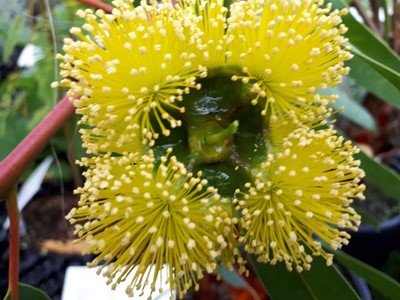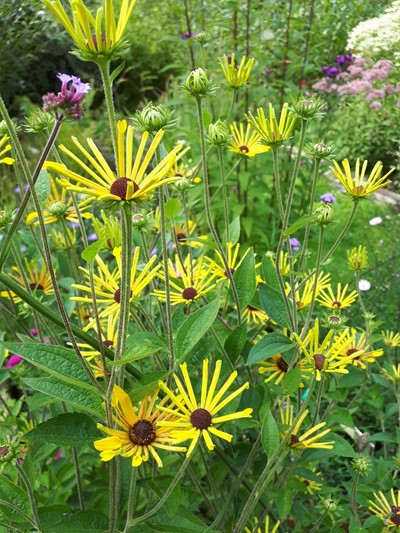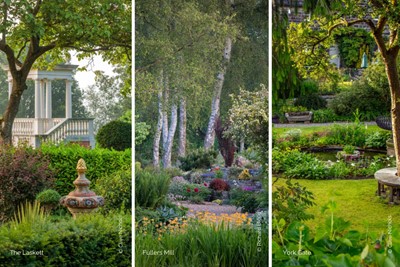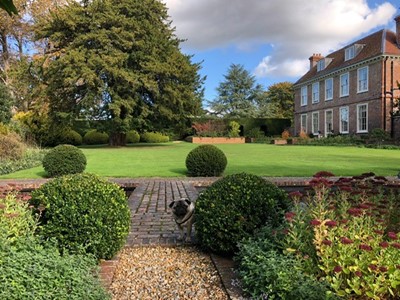Making a Sculpture Park
Monique Gudgeon, who owns and created the stunning gardens at Sculpture by the Lakes with her husband Simon, on how the gardens were created and what visitors can expect to see there. - 24 May 2019

“Nothing is more a child of art than a garden.”
Sir Walter Scott
I always seem to be writing about the garden when it’s looking at its absolute worst and my enthusiasm for it at a low ebb. January and February can be such grey dull months and this year they seem to be particularly so. The garden is in that awful ‘in between’ stage, half of it cleared and cut back but a lot still looking rather scruffy. At what point does a dead seed head go from frosted stark beauty to a pile of dead stuff? But the days are getting longer, already snowdrops and the Cyclamen coum are flowering and the daffodils along the drive and under the apple trees are forcing their way through the cold earth; my gardening fervour is warming to the tasks ahead, spring is coming!

I have attempted to create a modern garden using inspirations from many different sources both in this country and around the globe. Wherever we have placed sculpture I have kept the planting palette simple but dramatic so that the plants create a frame and the work remains the star of the show. Generous planting in every aspect means different areas of the garden are given specific shape and definition and of course there must be evergreens for winter interest. Experience has also taught me the importance of trusting to certain tried and tested species to deal with the more difficult soil conditions that we have here – there is no advantage in planting delicate lovelies that promptly die because they are too wet, wind-blown or frozen in winter.
Since our first gale-lashed, rain-sodden winter we have planted 3,500 or so trees and shrubs and many smaller herbaceous plants, bulbs and grasses. Mostly natives and what would have been growing here years before the lakes were dug and the ground generally messed about with, but our aim is to try and restore the original flora as much as possible. Now and then, like most gardeners, I do get tempted by the odd luscious and exotic specimen…..

Restored Wildflower Meadow alongside the River Frome
As well as a blank canvas of a garden to play with we also had similar free range over the rest of the land around the lakes, which had been heavily mowed and fenced in. Our first action was to take fences and gates away and to reduce grass cutting to the barest minimum. Well advised by Dorset Wildlife Trust, we allowed nature back in to reclaim her wild bits and set seed.
It is our greatest wish to leave the place in a better state than we found it, both for flora and fauna, and to make as small an impact on the environment as possible, if only it was that easy on a world-wide basis.
I hope above all that visitors enjoy the garden as much as I enjoy creating and improving it, I have stolen ideas from every garden I have ever visited and probably every garden book I’ve looked at, my thanks to all those unwitting contributors.
Making a Sculpture Park
When we first moved to Pallington Lakes back in the winter of 2007, grey, wet and dull as I remember, there was no formal garden to speak of. I had planned just two main areas of planting, which provided homes for trees, shrubs, climbers and assorted herbaceous that had been moved from our last garden. These two areas were christened the Walkway and the Bamboo and Exotic Garden, and that was the extent of my gardening ambition at that stage. The rest of the land, both around the house and further afield, was down to roughly mown grass. We had never moved here with the intention of creating a sculpture park, so we were happy at this stage to leave all as it was. It took us a further three months or so to realise that the land around the lakes would lend itself quite perfectly to the idea of an art park, but another three years of hard graft stood ahead of us before we were ready to take the plunge and open it as such.

House, Garden and Karikome and Land Art
The land can be roughly divided into two distinct areas; the sculpture park, which displays Simon’s work and where I have tried to be disciplined and minimalistic in my planting, and the garden near the house, where I can be completely selfish and indulge myself with whatever delicious beauty catches my eye. But always the art, and architecture or shape of the garden, remain the stars, be that the curving shape of a bed, or the way a particular sculpture is framed by the plants that surround it. Neither should distract from the other.

The Wise Walk - Sculpture: ‘Isis'
We have around thirty separate pieces of work displayed around the 26 acres of the park. The lakes lend themselves particularly well to showing bronze sculpture off, the water supplies both reflected light and a mirror, which works differently during the day and in the different seasons. Winter is a favourite time for me, the sculptures stand out but also the landscape shows its contours.

The sculpture ‘Thoth’ at the head of North Lake
We try to leave the ground around the lakes as natural as possible. However, where we have placed a piece of sculpture, I have created a frame, which shows the piece off to its best advantage. The planting in some cases is quite extensive and some serious landscaping has been undertaken. But for other pieces, mostly because the land itself has provided the stage, less is required. I keep the palette simple, only one species usually, so that the plants provide a strong but not distracting backdrop.
As well as encouraging grassland diversity with an ongoing wildflower meadow improvement, we have also planted a lot of trees. Our first major planting was a silver birch wood, which after eleven years is now providing excellent shelter and habitat as well as the simple beauty of their silver, pink and orange tinted trunks through which barn owls hunt for field voles on spring and summer evenings. The native trees already in residence have been further boosted by annual winter plantings which have included oak, beech, sweet chestnut and hornbeam, as well as various types of willow and poplar that love the boggy conditions down by the lakes and along the river. Together with these standard species, I have also indulged in some more esoteric varieties, which will add autumn colour and spring blossom. At the northern but more protected end of the lakes, I have planted several different flowering cherries which one day will, hopefully, stretch out across the water and reflect most artistically. Apparently, to plant trees is a sign that you have an optimistic nature!

I never in my wildest dreams imagined that one day I would have a garden that people would want to come and see. The emotion that I have invested is reflected in what visitors experience and I am constantly thrilled by guests who come back to the office just to say thank you and how much they have enjoyed themselves. ‘Transported’ is a word often used and ‘inspired’ is another, it is very humbling to know that it gives such pleasure. I haven’t set out the garden to any great plan, but what seems to have happened is the development of a very modern garden that reflects the spirit of Arcadia – surrounded by an idyllic and natural landscape, retaining the essences of unbounded nature but with the lightest of touches keeping the wilderness at bay.

Pippin’s Garden with a view towards Isis and the Wise Walk
Whenever I write about the garden, the planning, the planting, looking at other gardens that have provided inspiration, plus the joys and disappointments, as well as the mud, sweat and tears, it always reminds me of the fun that it is and how all these emotions and experiences combine to create the indefinable ‘something’ that makes gardening so utterly addictive.
Website: www.sculpturebythelakes.co.uk
Fairs
Past Fairs:

 Handy Plants for Climate Change - Read More..
Handy Plants for Climate Change - Read More..
 Hard-working Plants for Late Summer and Autumn Colour - Read More..
Hard-working Plants for Late Summer and Autumn Colour - Read More..
 Perennial: Supporting people in horticulture across the UK - Read More..
Perennial: Supporting people in horticulture across the UK - Read More..
 2026 Rare Plant Fair Dates - Read More..
2026 Rare Plant Fair Dates - Read More..
 The Manor House Garden, Bledlow - Read More..
The Manor House Garden, Bledlow - Read More..